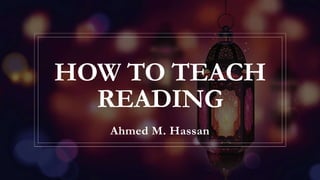
How to teach reading.pptx
- 1. HOW TO TEACH READING Ahmed M. Hassan
- 2. Introduction Reading is an activity which is done to catch ideas or information of a written text. By reading, the readers will get knowledge which is important in daily life activity. For the students at school, reading is an activity which can motivate them to be active in adding to their knowledge and activating their thinking process. During reading they catch and reach much information about anything from their reading. Reaching much information in reading will help the students have much knowledge, especially related to their study. Therefore, students are encouraged to do the reading activity and have good ability in it. It is done in order to provide the students with full of knowledge about everything. Besides, by reading well, the students can increase their background knowledge and experience from reading the text.
- 3. Reading Comprehension Reading comprehension is an active process and a complex activity that involves interaction between the readers and the text. In this case, it is not only based on readers’ comprehension skill but also their experience, background knowledge and interaction between them as readers and the writer. In reading comprehension, the readers are not only taking the information of the text but also applying their understanding in life.
- 4. Teaching Reading in the Classroom Teaching reading is an important activity done by the teacher in the classroom. It is an activity to help the students learn to read some words and sentences by giving the knowledge about the meaning of text. It is started from teaching students how to find the topic, main idea, as well as understand about the meaning in all paragraphs in the text. The teacher should guide the students to understand and comprehend the meaning of the text and get some new knowledge from the written text.
- 5. In teaching reading, there are three main activities that should be considered by the teacher.
- 6. 1. Pre- reading activity In this activity the students do not come into the reading activity yet, the teacher tries to activate students’ knowledge about the topic being discussed. The students are lead to recognise the topic and some stated information through skimming and scanning activities. The students are also guided to be familiar with some vocabularies included in the reading text. This activity is done only to attract students’ interest, motivation and enthusiasm till the end of reading activity.
- 7. 2. Whilst-reading activity This activity is usually assumed as the core of reading process. The students start to read the text and comprehend all information in the text. The students are also guided to identify main ideas on each paragraph, grasp all information comprehensively and try to make some clues of the vocabularies. In this activity the teacher encourages the students to focus on reading, so that the students will be easy to understand and know what they have read so far.
- 8. 3. Post-reading activity It is the end of reading section. In this activity the teacher tries to evaluate students’ comprehension of the reading text. The evaluation includes vocabulary, grammatical, meaning and summarising of the author’s purpose. In addition, to know these items, the teacher gives an exercise towards the students.
- 9. Teaching reading problems Students don’t like reading. The teacher does not have the necessary methodological knowledge about how to teach reading. It’s a national problem. Reading has little value in the culture. Students don’t know useful reading strategies. Students read “word by word”. Texts (topics of the texts) don’t fit student needs, interests and wants. The language level of the texts are too much higher or lower than the students language level. Lack of vocabulary needed to understand the text.
- 10. Possible route map for a reading lesson: Pre-text 1 Introduction and lead-in, e.g. get the learners interested in the topic, initial discussion of key themes, make an explicit link between the topic of the text and students’ own lives and experiences, focus on important language that will come in the text. 2 First task (pre-reading), e.g. predict from some extracted information (illustration, keywords, headlines), read questions about the text, students compose their own questions
- 11. Text 3 Tasks to focus on fast reading for gist (skimming), e.g. check text against predictions made beforehand, guess the title from a choice of three options, put events (or illustrations) in the correct order 4 Tasks to focus on fast reading to locate specific information (scanning) 5 Tasks to focus on meaning (general points), e.g. answer questions about meaning, make use of information in the text to do something (make a sketch, fill out a form, find out which picture is being described, etc.), discuss issues, summarise arguments, compare viewpoints 6 Tasks to focus on meaning (finer points of detail, more intensive comprehensive understanding) 7 Tasks to focus on individual language items, e.g. vocabulary or grammar exercises, use of dictionaries, work out meaning of words from context
- 12. Post-text 8 Follow-on task, e.g. role play, debate, writing task (e.g. write a letter in reply), personalisation (e.g. ‘Have you ever had an experience like this one?’) 9 Closing, e.g. draw the lesson to a conclusion, tie up loose ends, review what has been studied and what has been learned Learning Teaching by Jim Scrivener
